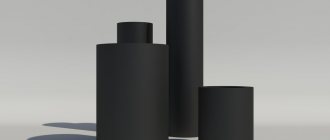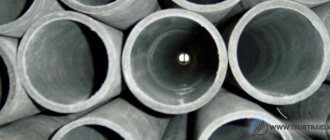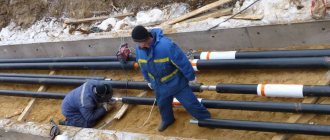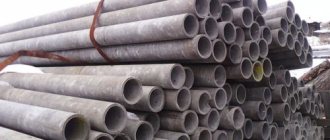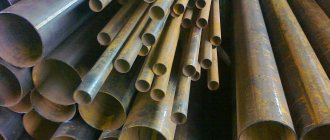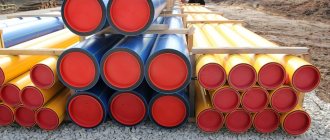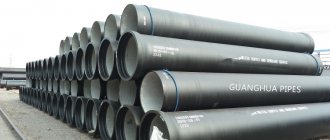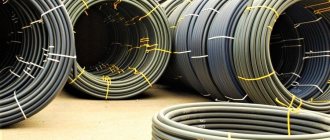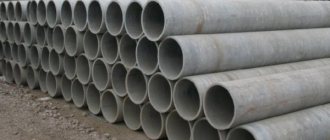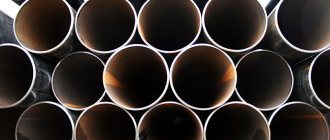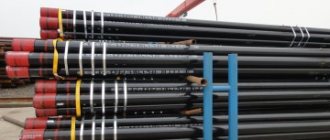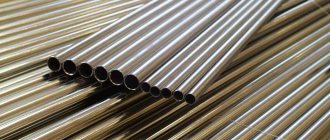Polyethylene products are used for the installation of pipelines for various purposes. Technical and operational characteristics allow the use of PE products for laying cables and power lines, transporting gas and liquids. Polyethylene communications have proven themselves in the installation of sewerage, drainage systems and pressure water supply. The parameters and properties of the pipe are regulated by GOST.
Polyethylene pipes are products widely used for installing water and gas pipelines, sewers and other communications.
Use of polyethylene products
There are pipes made of polyethylene (P) of high (H) and low (L) pressure (D). LDPE products have a limited area of use. Typically, pipelines for drinking water or other liquid media are built on their basis. LDPE pipes can be laid in the ground without the use of additional casings for protection.
High hardness, density, low flammability, flammability, and dielectric properties of HDPE pipes allow them to be used as the basis for sewer systems, water pipelines (both drinking and industrial water), gas pipelines, industrial pipelines, for laying cables and electrical wiring elements.
PVD is performed at an increased pressure value. Its melting point is about 110 degrees. The gas and moisture permeability of HDPE products is five times less than that of LDPE. They are excellent for outdoor piping.
Where are polyethylene (HDPE) pipes used?
The scope of application of HDPE pipes is determined based on the performance qualities of the material: high density, ability to withstand significant internal loads, low flammability and resistance to chemical reagents. Pipes made of low-density polyethylene are widely used in various fields of industry and the national economy.
- Sewage systems - for laying internal and external pressure and non-pressure communications.
- Cold water supply networks. HDPE pipes are widely used to supply drinking water (no foreign smell or taste, safe for health) and water for technical needs - for example, for irrigation in the agricultural industry.
- Organization of low pressure gas pipelines (HDPE pipes with a special mark “gas” are used).
- Transportation of aggressive liquids.
- Organization of drainage systems.
- Waterproofing sheath for power cables, electrical wiring, communications, where the determining indicator is the dielectric properties of HDPE.
- In monolithic construction as a formative element.
- When organizing well drilling and well digging.
Attention!
The main limitation of the use of polyethylene pipes, including HDPE, is the property of low fusibility - at temperatures above 110⁰C polyethylene begins to melt, and at 80⁰ it begins to soften. HDPE used in open spaces, where they are exposed to UV radiation, are produced with the addition of stabilizing components. You can read more about HDPE pipes in our article “Polyethylene (HDPE) PE-100 pipes”
Review of GOST standards for PE pipes
There are several standards (GOSTs) for polyethylene pipes. Each document defines the main characteristics, features, range and other important properties of products. Thus, we can distinguish GOST 18599, GOST 22689, GOST 32415, GOST 50838. The properties of PE as a material are prescribed in standard 16338, approved in 1985.
Polyethylene pipes are produced with or without color marking stripes
Document 18599-2001 applies to pressure pipes, which are divided into 3 types:
- Products made of PE with the possible presence of marking stripes.
- PE pipes having co-extrusion layers of the same MRS level (minimum – “minimum”, required – “long-term”, strength – “strength”) inside and/or outside.
- Polyethylene products with a protective shell made of thermoplastic.
GOST 22689, approved in 2014, establishes the technical parameters of shaped elements and PE pipes for the internal water drainage and sewage system. Document 50838 provides requirements for PE pipes for transporting gas, which is used as fuel and raw material in industry or municipal services.
Note! According to standard 18599, products for laying cables are produced.
GOST 32415 was approved in 2013 and applies to products made of thermoplastics, including polyethylene, pressure type for heating, cold water supply and connecting elements (fittings) to them.
State standards and their requirements
The technical characteristics of polyethylene pipes are regulated by the following regulatory documents:
- GOST 18599 2001. It contains requirements for PE pressure pipes used for transporting water (including domestic and drinking water supply) with a temperature of 0≤Т≤40 ºС. This GOST does not apply to polymer pipe products intended for moving flammable gases and for performing electrical installation work.
- GOST 22689 89 describes the characteristics of pipes and fittings for them, made of LDPE and HDPE (these abbreviations stand for high- and low-density polyethylene, respectively). This standard covers only those products that are used in internal sewerage systems of buildings with a maximum constant temperature of wastewater of +60 degrees and short-term (up to 1 minute) +95 ˚C.
Pipes with thick walls and large diameters are not rolled into coils, but are supplied only in straight sections of standard length
The melt fluidity, determined from the material of the finished product, should be no more than 2 g/10 min. The surface of the pipes must be smooth and even. On the outer surface, traces of no more than 0.5 mm in size from the calibrating and shaping tool are allowed. Pipes of this type cannot be rolled into coils. GOST 22689 89 does not regulate deviations from straightness.
After heating the pipes, the change in their dimensions in the longitudinal direction should not exceed 3%. These products should not crack in a 20 percent solution of the excipient OP-10, specified in GOST 8433 81, within 24 hours after heating to 80 ± 3 degrees. The connection of PE pipes GOST 18599 2001 with fittings will be considered airtight if it successfully passes the test with internal hydrostatic pressure of 1 kgf/m2 (0.1 MPa) at a temperature of +15 ± 10 degrees. Pipes, as well as shaped parts, must be produced from a melt of HDPE with a flow rate determined by GOST 16338. If LDPE is used as a raw material, then the value of this parameter is regulated by GOST 16337. In general, the range of values of the flow rate is as follows: 0.25≥ PT ≥1 ,5. Unit of measurement – g/10 min.
GOST R 50838 of 1995 provides for the production of polyethylene gas pipes in coils, straight sections and on reels. But with one clarification: products with a diameter of 225 and 200 mm are produced exclusively in sections, the length of which can vary in the range of 5 ≤L≤24 meters with a step ratio of adjacent values of 0.5 m. The permissible deviation of the length from the nominal value is no more than 1 percent.
On a note! In one batch, GOST 18599 2001 allows the presence of pipes with a length of 5 3 ≤L ≤ 5 meters for at least 5% of the total volume.
With regard to production in coils and on coils, the maximum deviation indicator is as follows:
- pipe length up to 500 mm – no more than 3 percent;
- pipe length from 500 mm – no more than 1.5 percent.
The length of pipes supplied in coils may differ from the standard as agreed with the customer
Production of polyethylene pipe products of other lengths and with other maximum deviations is allowed only by agreement with the customer. The minimum long-term strength indicator depends on the type of product and is used when calculating the operating pressure of the pipeline. Its designation contains 3 Latin letters MRS, followed by numbers. Polyethylene grade PE 100 corresponds to the marking MRS 10.0 MPa, PE 80 - MRS 8.0 MPa and PE 63 - MRS 6.3 MPa.
Characteristics of PE (GOST 16338)
Regulatory document 16338 regulates the technical parameters of HDPE (high density), which is obtained by gas-phase or suspension polymerization of ethylene (C2H4) at low pressure values.
Also listed here are compositions and grades of PE approved for the production of products in contact with drinking water, food, medicines and cosmetics, and other purposes. Pipes and films must be made from gas-phase compositions of the first and highest grades or suspension compositions of the second and first grades.
GOST regulates the composition of raw materials used for the production of a particular type of pipe
The document establishes maximum concentrations of harmful substances that can be released into food, water or air. The corresponding values are given in the table.
Table 1
| Product name | Permissible concentration, µg/m3 | Hazard class (GOST 12.1.007) |
| Formaldehyde | 500 | 2 |
| Acetaldehyde | 5 thousand | 3 |
| Carbon monoxide | 20 thousand | 4 |
| Organic acids (converted to acetic acid) | 5 thousand | 3 |
| Aerosol PE | 10 thousand | 3 |
HDPE (according to GOST 16338) is a flammable material. At room temperature, it does not release harmful substances into the environment. During processing, when values exceed 140 degrees, the release of volatile products that contain organic acids is possible.
What should the HDPE be according to GOST?
The production, transportation and storage of low-density polyethylene, from which pressure pipes are made, are regulated by the rules - GOST 16338-85, according to which the material receives a specific marking.
According to the standards, two technologies are used for the manufacture of HDPE, resulting in two types of material.
- Suspension, produced by polymerization of granular substance C2H4. GOST specifies the requirements for 10 basic grades of this HDPE.
- Gas-phase, manufactured in a gas reactor using catalysts, comonomers and other substances; the rules specify the requirements for the main 20 grades of such material.
Sheet HDPE is used for the production of various products, including pressure pipes, by thermoforming or mechanical processing. The main technical characteristics that low-density polyethylene must meet are as follows:
- the density of the material should be in the range from 0.931 – 0.970 g/cubic meter. cm;
- melting point – from 125⁰C and not higher than 132⁰C;
- granule density – not less than 0.5 g/cubic. cm;
- bending and tensile strength – from 19 MPa;
- electrical resistivity – from 1.014 kOhm;
- water absorption per calendar month is not higher than 0.04%.
GOST also regulates brands and compositions of HDPE, from which it is allowed to manufacture products that have contact with food, drinking water, pharmaceuticals, cosmetics, etc. For gas-phase HDPE type, the first and highest grades are allowed; for the type made from suspension material - the first and second.
Attention!
The requirements of GOST 16338-85 do not apply to products made of low-density polyethylene for the cable industry. This product is not subject to state standards.
Production of HDPE pipes
GOST standards for polyethylene products for cables, water pipes, sewerage, gas regulate not only the technological process of production of semi-finished HDPE products, but also pipes. Thus, according to standard 18599, there are two ways to obtain the final product:
- extrusion;
- casting.
Extrusion refers to the extrusion of a pipe from granules in a molten state. The product receives the required shape thanks to the extruder head. In this case, the superheated polymer is pushed out by the press.
The production of a pipe by casting is carried out using a rotating mold, to the walls of which the molten material sticks.
Note! This process is more complicated than extrusion, but it is possible to obtain HDPE pipes that are more accurate in size with minimal deviations and ovality.
There is another way to produce a pipe - pneumatic formation. In this case, the polymer is fed into the mold under pneumatic pressure, resulting in the formation of a HDPE product.
Extrusion is the easiest way to produce PE pipes
Depending on the chosen type of production and raw material characteristics, you can obtain a final product with different technical characteristics. HDPE pipes, GOSTs regulating their parameters, specific conditions of use - all these are important issues that require special attention when it is necessary to arrange a pipeline for gas, water, cables, etc.
What are the GOST standards for PE polyethylene pipes?
Polyethylene pipes are subject to several types of state standards, depending on the performance characteristics of the products, product range and other parameters.
- The properties of polyethylene as a material for the manufacture of pipes are regulated by GOST 16338, which was developed in 1985.
- The main document that specifies the conditions for the use of PE pipes is GOST 18599 2001, which replaced GOST 18599 83, which was in force until 2003. In addition to the areas and possibilities of use, it reflects the basic requirements for the production of polyethylene pipes, as well as the characteristics of the finished product. products. This type of standardization applies to PE pipes for transporting various liquids (water, juices, milk, etc.) and gases at temperatures not exceeding 40⁰C.
- Document 22689 2014 establishes the technical characteristics of shaped components and polyethylene pipes for sewer communications and internal drainage systems.
- GOST 50838 (the latest edition of GOST for gas pipes - GOST R 58121.2) regulates the requirements for PE pipes for laying a gas pipeline.
- For cable installation, the technical parameters of pipes are regulated by state standard 18599.
- GOST 32415 2013 regulates the conditions for the use of HDPE pressure pipes for water supply, heating and connecting parts to them.
- In addition, there is GOST 30732 2006, which regulates the rules for the use of polyethylene non-pressure products as polyurethane foam insulation for steel pipes.
Attention!
If you are interested in characteristics, assortment or where you can buy PE 100 pipes for cold water, then you can find out more about this in our subsection Pipes for cold water supply.
Dimensions of PE pipes according to document 32415
GOST for pipes (polyethylene) for water supply determines the main dimensions of products. The corresponding values from the standard are given in the table. SDR (SRO) – standard (“standard”) dimensional (“dimension”) ratio (“ratio”).
table 2
| Polyethylene grade | 80 | 80, 100 | ||||||||
| Series 2.5; SRO 6 | Series 3.2; SRO 7.4 | Series 4; SRO 9 | Series 5; SRO 11 | Series 6.3; SRO 13.6 | Series 8; SRO 17 | Episode 10; SRO 21 | Series 12.5; SRO 26 | Episode 16; SRO 33 | Episode 20; SRO 41 | |
| Diameter, *103 mm | Pipe wall, *10-1, mm | |||||||||
| 0,016 | 30 | 23 | 20 | — | — | — | — | — | — | — |
| 0,020 | 34 | 30 | 23 | 20 | — | — | — | — | — | — |
| 0,025 | 42 | 35 | 30 | 23 | 20 | — | — | — | — | — |
| 0,032 | 54 | 44 | 36 | 30 | 24 | 20 | — | — | — | — |
| 0,040 | 67 | 55 | 45 | 37 | 30 | 24 | 20 | — | — | — |
| 0,050 | 83 | 69 | 56 | 46 | 37 | 30 | 24 | 20 | — | — |
| 0,063 | 105 | 86 | 71 | 58 | 47 | 38 | 30 | 25 | — | — |
| 0,075 | 125 | 103 | 84 | 68 | 56 | 45 | 36 | 29 | — | — |
| 0,090 | 150 | 123 | 101 | 82 | 67 | 54 | 43 | 35 | — | — |
| 0,110 | 183 | 151 | 123 | 100 | 81 | 66 | 53 | 42 | — | — |
| 0,125 | 208 | 171 | 140 | 114 | 92 | 74 | 60 | 48 | — | — |
| 0,140 | 233 | 192 | 157 | 127 | 103 | 83 | 67 | 54 | — | — |
| 0,160 | 266 | 219 | 179 | 146 | 118 | 95 | 77 | 62 | — | — |
| 0,180 | 299 | 246 | 201 | 164 | 133 | 107 | 86 | 69 | — | — |
| 0,200 | 332 | 274 | 224 | 182 | 147 | 119 | 96 | 77 | — | — |
| 0,225 | 374 | 308 | 252 | 205 | 166 | 134 | 108 | 86 | — | — |
| 0,250 | 415 | 342 | 279 | 227 | 184 | 148 | 119 | 96 | — | — |
| 0,280 | 465 | 383 | 313 | 254 | 206 | 166 | 134 | 107 | — | — |
| 0,315 | 523 | 431 | 352 | 286 | 232 | 187 | 150 | 121 | 97 | 77 |
| 0,355 | 590 | 485 | 397 | 322 | 261 | 211 | 169 | 136 | 109 | 87 |
| 0,400 | 665 | 547 | 447 | 363 | 294 | 237 | 191 | 153 | 123 | 98 |
| 0,450 | — | 615 | 503 | 409 | 331 | 267 | 215 | 172 | 138 | 110 |
| 0,500 | — | 683 | 558 | 454 | 368 | 297 | 239 | 191 | 153 | 123 |
| 0,560 | — | — | 625 | 508 | 412 | 332 | 267 | 214 | 172 | 137 |
| 0,630 | — | — | — | 572 | 463 | 374 | 300 | 241 | 193 | 154 |
| 0,710 | — | — | — | 645 | 522 | 421 | 339 | 272 | 218 | 174 |
| 0,800 | — | — | — | — | 588 | 474 | 381 | 306 | 245 | 196 |
| 0,900 | — | — | — | — | 662 | 533 | 429 | 344 | 276 | 220 |
| 1,000 | — | — | — | — | 725 | 593 | 477 | 382 | 306 | 245 |
| 1,200 | — | — | — | — | 882 | 679 | 572 | 459 | 367 | 294 |
| 1,400 | — | — | — | — | 1029 | 824 | 667 | 535 | 429 | 343 |
| 1,600 | — | — | — | — | 1176 | 941 | 762 | 612 | 490 | 392 |
Maximum deviations in the dimensions of polyethylene pipes
GOST 32415 establishes permissible deviations in diameter and ovality of PE products.
Table 3
| Diameter, *1 thousand mm | Permissible deviation upward, *10-1, mm | Ovality mm * 10-2 no more |
| 0,016 | 3 | 120 |
| 0,020 | 3 | 120 |
| 0,025 | 3 | 120 |
| 0,032 | 3 | 130 |
| 0,040 | 4 | 140 |
| 0,050 | 4 | 140 |
| 0,063 | 4 | 150 |
| 0,075 | 5 | 160 |
| 0,090 | 6 | 180 |
| 0,110 | 7 | 220 |
| 0,125 | 8 | 250 |
| 0,140 | 9 | 280 |
| 0,160 | 10 | 320 |
| 0,180 | 11 | 360 |
| 0,200 | 12 | 400 |
| 0,225 | 14 | 450 |
| 0,250 | 15 | 500 |
| 0,280 | 17 | 980 |
| 0,315 | 19 | 1110 |
| 0,355 | 22 | 1250 |
| 0,400 | 24 | 1400 |
| 0,450 | 27 | 1560 |
| 0,500 | 30 | 1750 |
| 0,560 | 34 | 1960 |
| 0,630 | 38 | 2210 |
| 0,710 | 64 | — |
| 0,800 | 72 | — |
| 0,900 | 81 | — |
| 1,000 | 90 | — |
| 1,200 | 108 | — |
| 1,400 | 126 | — |
| 1,600 | 144 | — |
For the wall thickness of a PE pipe, GOST provides the following data (in millimeters).
Table 4
| Pipe wall made of polyethylene, *10-1 | Deviation upward in quality V | |
| > | ≤ | |
| 10 | 20 | 0,3 |
| 20 | 30 | 0,4 |
| 30 | 40 | 0,5 |
| 40 | 50 | 0,6 |
| 50 | 60 | 0,7 |
| 60 | 70 | 0,8 |
| 70 | 80 | 0,9 |
| 80 | 90 | 1,0 |
| 90 | 100 | 1,1 |
| 100 | 110 | 1,2 |
| 110 | 120 | 1,3 |
| 120 | 130 | 1,4 |
| 130 | 140 | 1,5 |
| 140 | 150 | 1,6 |
| 150 | 160 | 1,7 |
| 160 | 170 | 1,8 |
| 170 | 180 | 1,9 |
| 180 | 190 | 2,0 |
| 190 | 200 | 2,1 |
| 200 | 210 | 2,2 |
| 210 | 220 | 2,3 |
| 220 | 230 | 2,4 |
| 230 | 240 | 2,5 |
| 240 | 250 | 2,6 |
| 250 | 260 | 2,7 |
| 260 | 270 | 2,8 |
| 270 | 280 | 2,9 |
| 280 | 290 | 3,0 |
| 290 | 300 | 3,1 |
| 300 | 310 | 3,2 |
| 310 | 320 | 3,3 |
| 320 | 330 | 3,4 |
| 330 | 340 | 3,5 |
| 340 | 350 | 3,6 |
| 350 | 360 | 3,7 |
| 360 | 370 | 3,8 |
| 370 | 380 | 3,9 |
| 380 | 390 | 4,0 |
| 390 | 400 | 4,1 |
| 400 | 410 | 4,2 |
| 410 | 420 | 4,3 |
| 420 | 420 | 4,4 |
| 420 | 440 | 4,5 |
| 440 | 450 | 4,6 |
| 450 | 460 | 4,7 |
| 460 | 470 | 4,8 |
| 470 | 480 | 4,9 |
| 480 | 490 | 5,0 |
| 490 | 500 | 5,1 |
| 500 | 510 | 5,2 |
| 510 | 520 | 5,3 |
| 520 | 530 | 5,4 |
| 530 | 540 | 5,5 |
| 540 | 550 | 5,6 |
| 550 | 560 | 5,7 |
| 560 | 570 | 5,8 |
| 570 | 580 | 5,9 |
| 580 | 590 | 6,0 |
| 590 | 600 | 6,1 |
| 600 | 610 | 6,2 |
| 610 | 620 | 6,3 |
| 620 | 630 | 6,4 |
| 630 | 640 | 6,5 |
| 640 | 650 | 6,6 |
| 650 | 660 | 6,7 |
| 660 | 670 | 6,8 |
| 670 | 680 | 6,9 |
| 680 | 690 | 7,0 |
| 690 | 700 | 7,1 |
Basic design relationships
According to GOST, a polyethylene pipe can be used for 50 years at an operating temperature of 20 degrees. These values are inherent in cold water supply.
Pipes of small diameter and thin walls are most often used for transporting cold water in domestic conditions.
For it, the nominal pressure, design voltage and product series are related by the following ratio:
D = 10*N/S = 10*MRS/S*K,
where K is the safety factor in the form of a coefficient taking into account the operating conditions of the pipeline; C – pipe series; MRS – minimum value of long-term strength, expressed in MPa; N – design stress (in MPa).
If the pipeline carries water whose temperature is above 20 degrees, then the operating pressure value is corrected by entering a coefficient. In this case, the relation is used
D1 = D*K1,
where D1 is the permissible pressure, expressed in bar; D – nominal pressure; K1 – pressure reduction in coefficient form, the value of which is given in the table.
Table 5
| K1 value for polyethylene pipe | Water temperature, degrees |
| 1,00 | 20 |
| 0,93 | 25 |
| 0,87 | 30 |
| 0,80 | 35 |
| 0,74 | 40 |
Features of polyethylene pipes
All polymer pipes have common technical and operational characteristics. However, despite this, certain types of products of this type have their own characteristics. The distinctive properties of PE products include: the warranty period for polyethylene pipes GOST 18599 2001 is 50 years and the properties for transporting the working environment improve over time.
The throughput of a polyethylene pipeline increases for two main reasons:
- The boundary layer of the polymer swells over time. As a result, a specific effect of surface elasticity occurs, due to which the resistance to movement is reduced and the conditions for flow around the pipe walls are improved.
- Corrosion overgrowth of a metal pipe leads to a decrease in its internal diameter. At the same time, due to the characteristic creep property of polyethylene, the flow area of a product made from this material increases during operation without compromising its performance. In numbers, the increase looks like this: about 10% during the first 10 years and about 3% throughout the entire service life of the pipeline.
A wide range of operating temperatures is another important advantage. A polyethylene pipe that meets the requirements of GOST 18599 2001 does not lose its performance characteristics at significant negative temperatures (-70˚С) and retains its strength at +60˚С . When this mark is exceeded, the strength of PE decreases and it loses its ability to withstand high pressure.
Resistance to high pressure and low temperatures allows the use of polyethylene pipes for laying underground networks without any insulation
The coefficient of reduction in the value of this parameter for pipes made of polyethylene, depending on the temperature of the working environment, is presented in Table No. 1.
Table 1
| Liquid temperature, ˚С | Pressure reduction coefficient, Ct. | ||
| PE 100, PE 80 | PE 63 | PE 32 | |
| 36-40 | 0,74 | 0,62 | 0,3 |
| 31-35 | 0,8 | 0,72 | 0,47 |
| 26-30 | 0,87 | 0,81 | 0,65 |
| 21-25 | 0,93 | 0,9 | 0,82 |
| Less than 20 | 1,0 | 1,0 | 1,0 |
The elasticity of pipes, in addition to ease of installation, has a positive effect on the transportation of these products. It is allowed to deliver pipes with a diameter of no more than 160 mm to the consumer in coils longer than 200 meters. You can cut them with a regular hacksaw. Utility networks are assembled from such pipes using special couplings, fittings and other parts.
Important! Exposure to direct sunlight causes polyethylene to age. Therefore, in external communications, pipes made of polymer stabilized by carbon black should be used.
Technical requirements according to GOST 32415
Pipes must be smooth both inside and outside. Fulfilling this requirement is important to ensure the specified pipeline capacity. Slight waviness and the presence of longitudinal stripes are allowed.
Note! The surface should be free of bubbles, cavities, foreign inclusions and cracks.
One of the quality indicators of PE pipes is the absolute smoothness of the external and internal surfaces of the products.
The resistance of pipes (GOST 32415) to internal pressure is determined during tests, the modes of which are given in the table.
Table 6
| No. | Test time, min., not less | Test temperature, degrees | Hoop (hydrostatic) stress for PE brand, kPa | |
| 100 | 80 | |||
| 1 | 6 thousand | 20 | 12 thousand | 10 thousand |
| 2 | 165*60 | 80 | 5400 | 4500 |
| 3 | 60 thousand | 80 | 5 thousand | 4 thousand |
In case of plastic failure for the second mode, the tests are repeated under the conditions specified in the table.
Table 6
| Grade PE 100 | Grade PE 80 | ||
| Hydrostatic stress, kPa | Time, h | Time, h | Hydrostatic stress, MPa |
| 5400 | 165 | 165 | 4,5 |
| 5300 | 256 | 233 | 4,4 |
| 5200 | 399 | 331 | 4,3 |
| 5100 | 629 | 474 | 4,2 |
| 5 thousand | 1 thousand | 685 | 4,1 |
| — | — | 1 thousand | 4,0 |
Water pipes can lengthen after heating at a temperature of 110±2 ºС by no more than 3%. In this case, the tests last 60±2 minutes for products with a wall up to 8 mm, 120±2 minutes - from 8 to 16 mm and 240±2 minutes - more than 16 mm. When ruptured, the relative elongation of pipe grades 80 and 100 is no less than 350%. The change in MFI compared to the original is no more than 20 percent, thermal stability at a temperature of 200 degrees is no less than 20 minutes.
Tests of PE pipes are carried out under high pressure
Resistance parameters of pipe connections
Polyethylene pipes connected by fittings must meet the requirements of the standard. The welded joint of products and its technical durability parameters are checked during tests at a temperature of 80 ºС for at least 165 hours at a hydrostatic (hoop) stress of 5.4 MPa (for PE 100) and 4.5 MPa (for PE 80).
Mechanical connections of polyethylene pipes are checked under the conditions indicated in the table.
Table 7
| Test scheme | Pressure, bar | Temperature, degrees | Test time, not less, h |
| Without bending PE pipes | 1.5*nominal pressure | 20 | 1 |
| With bend | 1 |
Mechanical connections are also subject to testing for resistance to tensile load (at a temperature of 20 degrees for at least an hour), which is calculated using the formula:
RN = 1.5*N*π*(ND-TS)*TS,
where РН – tensile load, N; N – permissible stress: 8 MPa (for PE 80), 10 MPa (for PE 100); ND – nominal value of outer diameter, mm; TS – average value of wall thickness, mm.
The bending radius can be 15 outer diameters of the pipe (in mm) if the nominal pressure is ≤10 and 20 outer diameters if greater than 10. The nominal pressure must be selected from the table.
Table 8
| Series | SDR | Nominal pressure for polyethylene brand, *10-1 | |
| 80 | 100 | ||
| 20 | 41 | 32 | 40 |
| 16 | 33 | 40 | 50 |
| 12,5 | 26 | 50 | 60 |
| 10 | 21 | 60 | 80 |
| 8 | 17 | 80 | 100 |
| 6,3 | 13,6 | 100 | 125 |
| 5 | 11 | 125 | 160 |
| 4 | 9 | 160 | 200 |
| 3,2 | 7,4 | 200 | 250 |
| 2,5 | 6 | 250 | — |
If compression fittings are used for connection, the test pressure must correspond to the values in the table (symbol: ND - nominal pressure).
Each method of connecting PE pipes must comply with accepted standards
Table 9
| Test temperature, degrees | Time, h, no less | Pressure, bar, for fittings made of | ||||
| PP-R | PP-B | PP-H | P.O.M. | ABS | ||
| 20 | 1 thousand | 1.2*ND | 1.5*ND | |||
| 40 | 0.8*ND | 1.1*ND | ||||
How to calculate the basic ratios for PE pipes?
According to GOST standards, polyethylene cold water supply pipes at an operating temperature of 20⁰C can be used for 50 years. The ratio of the nominal pressure, design voltage and series of PE pipes will look like this:
D = 10 x N/S = 10 x MRS/C x K, where D is pressure, N is design stress, C is product series, MRS is the minimum long-term strength indicator, K is the safety factor taking into account the operating conditions of the pipeline. All values are expressed in MPa.
If the water supply system transports water at a higher temperature, a coefficient is entered to calculate the permissible pressure value.
The formula looks like this: D1 = D x K1, where D1 is the permissible pressure indicator, D is the nominal pressure, K1 is the pressure reduction coefficient. The coefficient values depending on temperature are presented in the table.
| K1 for PE pipes | Water temperature in ⁰C |
| 1 | 20 |
| 0,93 | 25 |
| 0,80 | 35 |
| 0,74 | 40 |
Table of dependence of pressure reduction coefficient on temperature
The basic ratios of polyethylene pipes are regulated by state standard 18599 2001.
Dimensions of polyethylene sewer products
Sewage pipes (GOST 22689) are characterized by the dimensions indicated in the table.
Table 10
| Nominal size, * 10-1 mm | External diameter (nominal), *10 mm | Average outer diameter, *10-1 mm | |
| maximum | minimum | ||
| 320 | 3,2 | 323 | 320 |
| 400 | 4,0 | 404 | 400 |
| 500 | 5,0 | 505 | 500 |
| 630 | 6,3 | 636 | 630 |
| 750 | 7,5 | 757 | 750 |
| 800 | 8,0 | 808 | 800 |
| 900 | 9,0 | 909 | 900 |
| 1 thousand | 10,0 | 1009 | 1 thousand |
| 1100 | 11,0 | 1110 | 1100 |
| 1250 | 12,5 | 1262 | 1250 |
| 1600 | 16,0 | 1615 | 1600 |
| 2 thousand | 20,0 | 2018 | 2 thousand |
| 2500 | 25,0 | 2523 | 2500 |
| 3150 | 31,5 | 3179 | 3150 |
The standard also establishes the value of wall thickness.
Table 11
| Outer diameter (nominal), *10 mm | Wall, *10-1 mm | |||
| For series 12.5 | For series 16 | |||
| maximum | maximum | minimum | minimum | |
| 3,2 | 35 | 30 | 35 | 30 |
| 4,0 | ||||
| 5,0 | ||||
| 6,3 | ||||
| 7,5 | ||||
| 8,0 | 36 | 31 | ||
| 9,0 | 41 | 35 | ||
| 10,0 | 44 | 38 | 38 | 32 |
| 11,0 | 49 | 42 | 40 | 34 |
| 12,5 | 55 | 48 | 45 | 39 |
| 16,0 | 71 | 62 | 56 | 49 |
| 20,0 | 87 | 77 | 71 | 62 |
| 25,0 | 108 | 96 | 87 | 77 |
| 31,5 | 136 | 121 | 109 | 97 |
Other wall thicknesses of products at any point are also acceptable, but not more than 1.25 of the minimum limit.
For the installation of pressure sewer systems, smooth and corrugated pipes with thick walls are used
What does SDR mean?
One of the main indicators of the strength characteristics of a polyethylene pipe, which is provided for by GOST and must be indicated during labeling, is SDR. This parameter allows you to determine the capabilities of products. Explanation of this designation in English (Standard Dimension Ratio) is a standard dimensional ratio.
The SDR coefficient of a pipe shows the ratio of its outer diameter to the wall thickness; the following formula is used to calculate the indicator:
SDR = D : S, where D is the outer diameter (in mm) and S is the pipe wall thickness (in mm).
The higher the SDR coefficient, the thinner the pipe wall, and vice versa - for a pipe with thick walls this indicator is lower. Thus, a pipe with a low SDR will have greater capabilities and ability to withstand severe loads than a product with a high ratio.
Important!
If you choose a product with the best performance characteristics from pipes of the same diameter and with different SDR values (for example, 17 and 21), you should give preference to a smaller coefficient - 17. However, you need to take into account: the greater the wall thickness, the lower the throughput of the pipe due to its reduction internal section.
Technical parameters of sewer pipe
A polyethylene pipe (GOST 22689) for sewerage after heating can be extended by no more than 3%. In this case, the appearance of cracks or bubbles is unacceptable. Change in MFR for pipes that are intended for butt welding – no more than 2*10-1 g/10 minutes.
If pipes and fittings with a seal are to be connected, then water tightness without leaks at an internal pressure of 0.05 MPa should be within 15 minutes, and air tightness at a pressure of 0.01 MPa - within 5 minutes. The MFR indicators for products comply with GOST 11645.
Note! The document allows for the addition of recycled material of the same grade to the composition.
HDPE pipes have a high degree of rigidity due to their crystalline structure. They are distinguished by high strength, density, and low elastic modulus. The main document for a pressure sewer pipe (SPE) is GOST 18599.
GOST in the production of polyethylene pipes
Standardization of polyethylene products concerns not only technologies for the production of HDPE sheets, but also the production of pressure pipes. According to the provisions of GOST 18599, the final product is produced in two main ways:
- by extrusion (the molten polymer is squeezed out with a press, and the pipe is given the desired shape using an extruder head);
- by casting method (molten polyethylene adheres to the walls of a special mold, which rotates at high speed).
Another method for producing HDPE pressure pipes is by pneumatic forming. In this case, the molten substance is fed into the mold under pneumatic pressure, resulting in a finished product.
Important!
The injection molding method is more complicated than extrusion, but the latter method produces finished pipes with minimal deviations in size and ovality.
Weight of polyethylene pipe for sewerage
GOST 18599 establishes the weight of 1 meter of pipeline made of PE products.
Table 12
| External diameter, *103 mm | Weight, g | ||||||||
| SRO – 41, series 20 | SRO – 26, series 12.5 | SRO – 21, episode 10 | SRO – 17.6, series 8.3 | SRO – 17, episode 8 | SRO – 13.6, series 6.3 | SRO – 11, episode 5 | SRO – 9, episode 4 | SRO – 6, series 2.5 | |
| 0,010 | — | — | — | — | — | — | — | — | 52 |
| 0,012 | — | — | — | — | — | — | — | — | 65 |
| 0,016 | — | — | — | — | — | — | 92 | 92 | 116 |
| 0,020 | — | — | — | — | — | — | 118 | 134 | 182 |
| 0,025 | — | — | — | 151 | — | 151 | 172 | 201 | 280 |
| 0,032 | — | — | 197 | 197 | 197 | 233 | 280 | 329 | 459 |
| 0,040 | — | 249 | 249 | 286 | 297 | 358 | 432 | 511 | 713 |
| 0,050 | — | 315 | 376 | 443 | 456 | 552 | 669 | 798 | 1100 |
| 0,063 | 401 | 497 | 582 | 691 | 724 | 885 | 1060 | 1270 | 1750 |
| 0,075 | 480 | 678 | 831 | 981 | 1020 | 1250 | 1490 | 1790 | 2480 |
| 0,090 | 643 | 982 | 1190 | 1420 | 1480 | 1800 | 2150 | 2590 | 3580 |
| 0,110 | 946 | 1440 | 1780 | 2090 | 2190 | 2660 | 3200 | 3840 | 5340 |
| 0,125 | 1240 | 1870 | 2290 | 2690 | 2810 | 3420 | 4160 | 4960 | 6900 |
| 0,140 | 1550 | 2350 | 2890 | 3390 | 3520 | 4290 | 5190 | 6240 | — |
| 0,160 | 2010 | 3080 | 3770 | 4410 | 4600 | 5610 | 6790 | 8130 | — |
| 0,180 | 2500 | 3850 | 4730 | 5570 | 5830 | 7100 | 8590 | 10300 | — |
| 0,200 | 3090 | 4770 | 5880 | 6920 | 7180 | 8750 | 10600 | 12700 | — |
| 0,225 | 3910 | 5980 | 7450 | 8740 | 9120 | 11100 | 13400 | 16100 | — |
| 0,250 | 4890 | 7430 | 9100 | 10800 | 11200 | 13700 | 16500 | 19800 | — |
| 0,280 | 6090 | 9290 | 11500 | 13500 | 14000 | 17100 | 20700 | 24900 | — |
| 0,315 | 7630 | 11800 | 14500 | 17100 | 17800 | 21700 | 26200 | 31500 | — |
| 0,355 | 9740 | 14900 | 18400 | 21600 | 22600 | 27500 | 33300 | 40000 | — |
| 0,400 | 12300 | 18900 | 23400 | 27500 | 28600 | 34900 | 42300 | 50700 | — |
| 0,450 | 15600 | 23900 | 29600 | 34800 | 36300 | 44200 | 53600 | 64200 | — |
| 0,500 | 19300 | 29500 | 36500 | 42900 | 44800 | 54700 | 66100 | 79200 | — |
| 0,560 | 24100 | 37100 | 45800 | 53700 | 56100 | 68500 | 82800 | — | — |
| 0,630 | 30500 | 47000 | 57800 | 68100 | 71200 | 86688 | 104800 | — | — |
| 0,710 | 38800 | 59700 | 73600 | 86400 | 90300 | 110000 | — | — | — |
| 0,800 | 49300 | 75600 | 93300 | 109700 | 114500 | 139700 | — | — | — |
| 0,900 | 62100 | 95700 | 118100 | 138900 | 144700 | — | — | — | — |
| 1,000 | 76900 | 118100 | 145900 | 171300 | 178900 | — | — | — | — |
| 1,200 | 110800 | 170100 | 209800 | — | — | — | — | — | — |
High-quality pipes should not become unusable when butt welding
When calculating the mass, the density of polyethylene was assumed to be 950 kg/m3.
Characteristics of gas pipes
GOST establishes the required technical parameters for polyethylene products intended for gas. Some of the indicators are common to both grades of material (80 and 100). Thus, the established density should be more than 930 kg/m3, the spread of MFR should be ±20%, the mass fraction of soot (carbon black) should be 2.0-2.5%, and volatile substances should not be more than 350 mg/kg.
Indicators that are different for different brands of polyethylene are given in the table (symbol: BRT - rapid propagation of cracks).
Table 13
| Index | Value for polyethylene grade, *10 | Unit | |
| 100 | 80 | ||
| MTR at 190º/5 kgf | 0,01-0,05 | 0,03-0,12 | g/10 minutes |
| MRI resistance at 80 degrees for products with a nominal diameter of 160 or 110 mm and SDR 11 | 50 (at initial stress 4600 kPa) | 50 (at an initial stress of 4 thousand kPa) | no less than h |
Gas pipes of different brands differ in the calculated safety factor, which is given in the table.
Table 14
| Maximum operating pressure, kPa | Safety factor value | ||||||
| 300 | 400 | 600 | 800 | 1000 | 1200 | ||
| For PE 80 | SDR 26 | 2,1 | — | — | — | — | — |
| SDR 21 | 2,7 | 2,0 | — | — | — | — | |
| SDR 17.6 | 3,2 | 2,4 | — | — | — | — | |
| SDR 17 | 3,3 | 2,5 | — | — | — | — | |
| SDR 13.6 | 4,2 | 3,2 | 2,1 | — | — | — | |
| SDR 11 | 5,3 | 4,0 | 2,7 | 2,0 | — | — | |
| SDR 9 | 6,7 | 5,0 | 3,3 | 2,5 | 2,0 | — | |
| For PE 100 | SDR 26 | 2,7 | 2,0 | — | — | — | — |
| SDR 21 | 3,3 | 2,5 | — | — | — | — | |
| SDR 17.6 | 4,0 | 3,0 | 2,0 | — | — | — | |
| SDR 17 | 4,2 | 3,1 | 2,1 | — | — | — | |
| SDR 13.6 | 5,3 | 4,0 | 2,6 | — | — | — | |
| SDR 11 | 6,7 | 5,0 | 3,3 | 2,5 | 2,0 | — | |
| SDR 9 | 8,3 | 6,2 | 4,2 | 3,1 | 2,5 | 2,1 | |
Gas pipes are selected according to strength parameters, the choice depends on the pressure in the future pipeline
SDR index of polyethylene pipes
When purchasing such products, pay special attention to the markings on them. It contains the following data about a specific pipe:
- information about the manufacturer;
- GOSTs, in accordance with the requirements of which it was manufactured;
- brand of polyethylene, for example, PE 100;
- thickness of the material of the walls of the product and its diameter;
- the abbreviation SDR followed by a certain index. This is a strength indicator that provides the most accurate information about the capabilities of pipe products
The abbreviation SDR comes from the English term Standard Dimension Ratio, which in Russian translation sounds like this: Standard Dimensional Ratio. Its value is calculated by dividing the outer diameter by the wall thickness of the polyethylene pipe GOST 18599 2001.
SDR = Outside Diameter/Wall Thickness.
A simple analysis of this formula says that products with a lower SDR index have thicker walls, and, conversely, a thin-walled pipe corresponds to a larger value of this index. Differences in “pressure classes” of similar products depending on SDR are presented in Table No. 2.
table 2
| SDR 41 | SDR 33 | SDR 26 | SDR 21 | SDR 17,6 | SDR 17 | SDR 13,6 | SDR 11 | SDR 9 | SDR 7,4 | SDR 6 |
| 4 atm. | 4 atm. | 5 atm. | 6 atm. | 7 atm. | 8 atm. | 10 atm. | 12 atm. | 16 atm. | 20 atm. | 25 atm. |
In general, this indicator, along with the thickness of the polyethylene layer, indicates what level of load or pressure (internal and external) a polyethylene pipe GOST 18599 2001 can withstand.
Pressure networks require the use of pipes with an SDR rating of 6-9
This standard dimensional coefficient is recommended to be used when determining the suitability of a pipe for the implementation of a specific system - free-flow and pressure, namely:
- pipes with SDR 6-9, in addition to supplying water, are suitable for arranging pressure sewer collectors and even gas pipelines;
- products indexed from 11 to 17 can be used to create low-pressure water supply and irrigation systems;
- polyethylene pipe products with SDR ratings of 21-26 can be used to organize low-pressure intra-house water supply for multi-storey buildings. And, for example, PE 100 pipes with SDR 26 have found application in the food industry: they transport juice, milk, beer or wine;
- pipes with SDR 26-41 are used for gravity (free-flow) sewer outlets.
Important! Taking into account the grade of polyethylene is one of the most important conditions for the correct selection of pipes made from it. Even with the same SDR, a product whose marking contains a larger number, for example, PE 100 rather than PE 80, will be more resistant to various mechanical influences.
Below are some examples regarding the use of PE 80 pipes.
- PE 80 pipes with SDR 21 are characterized by low internal pressure and compressive strength. Therefore, it is not recommended to use them for installing a gas pipeline, burying them in the ground, or for pressure systems.
- PE 80 products with an SDR index of 17 are recommended for installing water supply systems in low-rise buildings. For this, their level of strength is quite sufficient. And the low weight and low cost will allow you to save on installation.
- PE 80 pipe with an SDR of 13.6 is very durable and can be used to build a long-term water supply system.
A pipe with a low strength index is suitable only for use in networks with low pressure, for example, in a watering system for a summer cottage
HDPE pipes for cable
GOST 18599 defines the characteristics of technical pipes that can be used for laying and protecting cables.
Note! In the production of such a product, it is allowed (upon agreement with the consumer) to use recycled materials, which reduces the base cost by approximately 50%.
Polyethylene cable pipes are beneficial not only financially, but also in practical terms. Such communications cannot withstand internal pressure, which leads to limitations in their use:
- for non-pressure sewerage;
- as a case for the power cable.
Technical pipes are usually supplied in coils of one hundred or two hundred meters, as well as in sections of 12 meters. Different wall thicknesses determine the classification of the product into one of the rigidity options (see table).
Table 15
| SDR | 26 | 21 | 17,6 | 13,6 | 11 | 9 |
| Type | "SL" | "OS" | "WITH" | "ST" | "T" | "FROM" |
Range of technical pipes
Technical pipes have the characteristics presented in the table.
Table 16
| Diameter, *10-1 mm | Type "SL" | Type "OS" | Type "C" | Type "ST" | Type "T" | |||||
| Weight, g | Wall, *10-2 mm | Weight, g | Wall, *10-2 mm | Weight, g | Wall, *10-2 mm | Weight, g | Wall, *10-2 mm | Weight, g | Wall, *10-2 mm | |
| 160 | — | — | — | — | — | — | — | — | 92 | 200 |
| 200 | — | — | — | — | — | — | — | — | 116 | 200 |
| 250 | — | — | — | — | — | — | 148 | 200 | 169 | 230 |
| 320 | — | — | — | — | 197 | 200 | 229 | 240 | 277 | 300 |
| 400 | — | — | — | — | 281 | 230 | 353 | 300 | 427 | 370 |
| 500 | — | — | — | — | 436 | 290 | 545 | 370 | 663 | 460 |
| 630 | — | — | 573 | 300 | 682 | 360 | 869 | 470 | 1050 | 580 |
| 750 | — | — | 821 | 360 | 970 | 430 | 1230 | 560 | 1460 | 680 |
| 900 | 969 | 350 | 1180 | 430 | 1400 | 520 | 1760 | 670 | 2120 | 820 |
| 1100 | 1420 | 420 | 1770 | 530 | 2070 | 630 | 2610 | 810 | 3140 | 1000 |
| 1250 | 1830 | 480 | 2260 | 600 | 2660 | 710 | 3370 | 920 | 4080 | 1140 |
| 1400 | 2310 | 540 | 2830 | 670 | 3350 | 800 | 4220 | 1030 | 5080 | 1270 |
| 1600 | 3030 | 620 | 3710 | 770 | 4350 | 910 | 5500 | 1180 | 6670 | 1460 |
| 1800 | 3780 | 690 | 4660 | 860 | 5470 | 1020 | 6980 | 1330 | 8430 | 1640 |
| 2000 | 4680 | 770 | 5770 | 960 | 6780 | 1140 | 8560 | 1470 | 10400 | 1820 |
| 2250 | 5880 | 860 | 7290 | 1080 | 8550 | 1280 | 10900 | 1660 | 13200 | 2050 |
| 2500 | 7290 | 960 | 8920 | 1190 | 1060 | 1420 | 13400 | 1840 | 16200 | 2270 |
Advantages of HDPE pipes over steel ones
Polymer pipes are very common nowadays. The breadth of their use is determined by a number of positive characteristics.
One of the advantages of PE pipes is their resistance to corrosion, which allows underground communications to be laid without additional protection.
PE products are significantly cheaper than steel pipes and have a guaranteed service life of at least fifty years. Since HDPE pipes (GOSTs 18599, 22689, 32415 and 50838) do not require the use of cathodic protection, there is no need for their further maintenance.
Such products are not afraid of corrosion or exposure to chemicals. The low weight makes installation work easier. In addition, installation is reduced in cost due to butt welding of PE pipes. Water frozen inside the pipeline does not destroy it, maintaining complete tightness and integrity.
HDPE pressure pipes provide good protection against microorganisms and bacteria. The smooth inner surface provides excellent throughput. When using such pipes, the purity of the transported liquid is guaranteed, which makes it possible to install drinking water pipelines based on polyethylene products.
Features of HDPE pipe marking
Information about the characteristics of the products, expressed in alphabetic and symbolic form, is available on the outer surface of the pipes. The ability to read such markings greatly simplifies the process of selecting suitable communications and allows you to avoid critical errors during pipeline assembly.
The marking of polyethylene products includes the name of the manufacturing company, as well as the designation of the standard according to which such products are made, for example, GOST 18599.
Note! The name of the pipe material has an international format: PE 100 (or 63, or 80).
After the polymer grade, a group of numbers is indicated that corresponds to the outer diameter. This value is given in millimeters and corresponds to the product range. In addition to the external dimensions, the marking also includes internal dimensions - wall thickness. It is also expressed in millimeters.
Technical data is indicated on the outer surface of the pipe at certain intervals
An important characteristic that you should definitely pay attention to when choosing a HDPE pipe is the nominal pressure. Sometimes manufacturers also indicate the maximum value of this parameter, expressed in MPa.
The final marking items are the batch number and the date of manufacture of the product.
HDPE sewer pipes - technical indicators
A separate standard GOST 22689 regulates the requirements for PE pipes for sewer communications. The document regulates the parameters that the products must meet, as well as the characteristics of pipes, bends, plugs and other shaped elements. Standards normalize diameters, as well as the relationship with wall thickness and the maximum length of segments. Main characteristics of PE pipes for sewer communications:
- For sewerage installation, polyethylene pipes are produced, free-flow - with a pressure indicator of 5 atmospheres, pressure - with a pressure of 20 atmospheres.
- PE pipes with a diameter of 40 to 280 mm, made of PE 100 or PE80 material, are used.
- The indicator for the wall thickness of a PE sewer pipe depending on the outer diameter is from 30 to 136 mm.
- The rate of stretching of a PE sewer pipe after heating is no more than 3%, moreover, cracking and the appearance of bubbles is unacceptable.
- The MFR of products intended for butt welding should not exceed 2 x 10-1g/10 minutes.
- The parameters of PTR values for sewer pipes are regulated by GOST 11645.
- When connecting parts of the pipeline using shaped elements with seals, the water tightness rating should reach 15 minutes (at a pressure of 0.05 MPa), the air tightness rating should reach 5 minutes (pressure 0.01 MPa).
- The recommended permissible operating temperature is 40⁰C; at higher temperatures, the pipe walls soften.
Attention!
There are no uniform standards for corrugated PE products supplied in rolls and lengths, so usually manufacturers use their own technical specifications for the manufacture of such pipes, discussing them with the customer of the product.
PE with increased heat resistance
GOST 32415 identifies a special type of polyethylene that has increased heat resistance. The assortment is given in the table.
Table 17
| Series | 2,5 | 3,2 | 4 | 5 | 6,3 | 8 |
| SRO | 6 | 7,4 | 9 | 11 | 13,6 | 17 |
| Diameter, *102 mm | Product wall, *10-2, mm | |||||
| 0,10 | 170 | 140 | 130 | 130 | 130 | 130 |
| 0,12 | 200 | 180 | 140 | 130 | 130 | 130 |
| 0,16 | 270 | 220 | 180 | 150 | 130 | 130 |
| 0,20 | 340 | 280 | 230 | 190 | 150 | 130 |
| 0,25 | 420 | 350 | 280 | 230 | 190 | 150 |
| 0,32 | 540 | 440 | 360 | 290 | 240 | 190 |
| 0,40 | 670 | 550 | 450 | 370 | 300 | 240 |
| 0,50 | 830 | 690 | 560 | 460 | 370 | 300 |
| 0,63 | 1050 | 860 | 710 | 580 | 470 | 380 |
| 0,75 | 1250 | 1030 | 840 | 680 | 560 | 450 |
| 0,90 | 1500 | 1230 | 1010 | 820 | 670 | 540 |
| 1,10 | 1830 | 1510 | 1230 | 1000 | 810 | 660 |
| 1,25 | 2080 | 1710 | 1400 | 1140 | 920 | 740 |
| 1,40 | 2330 | 1920 | 1570 | 1270 | 1030 | 830 |
| 1,60 | 2660 | 2190 | 1790 | 1460 | 1180 | 950 |
| 1,80 | 2990 | 2460 | 2000 | 1640 | 1330 | 1070 |
| 2,00 | 3320 | 2740 | 2240 | 1820 | 1470 | 1190 |
| 2,25 | 3740 | 3080 | 2520 | 2050 | 1660 | 1340 |
| 2,50 | 4150 | 3420 | 2790 | 2270 | 1840 | 1480 |
| 2,80 | 4650 | 3830 | 3130 | 2540 | 2060 | 1660 |
| 3,15 | 5230 | 4310 | 3520 | 2860 | 2320 | 1870 |
| 3,55 | 5900 | 4850 | 3970 | 3220 | 2610 | 2110 |
| 4,00 | 6650 | 5470 | 4470 | 3630 | 2940 | 2370 |
| 4,50 | — | 6150 | 5030 | 4090 | 3310 | 2670 |
| 5,00 | — | 6830 | 5580 | 4540 | 3680 | 2970 |
| 5,60 | — | — | 6250 | 5080 | 4120 | 3320 |
| 6,30 | — | — | — | 5720 | 4630 | 3740 |
| 7,10 | — | — | — | 6450 | — | — |
Such pipes can be produced in straight sections, coils, or coils. The deviation of products with a length of up to 12 meters should be 10 mm in the larger (or smaller) direction. Maximum dimensional deviations and ovality are given in the table.
Table 18
| Diameter, *100 mm | Larger deviation, mm | Permissible ovality, no more than *10-1 mm |
| 0,10 | 0,3 | 11 |
| 0,12 | 0,3 | 11 |
| 0,16 | 0,3 | 12 |
| 0,20 | 0,3 | 12 |
| 0,25 | 0,3 | 12 |
| 0,32 | 0,3 | 13 |
| 0,40 | 0,4 | 14 |
| 0,50 | 0,5 | 14 |
| 0,63 | 0,6 | 16 |
| 0,75 | 0,7 | 16 |
| 0,90 | 0,9 | 18 |
| 1,10 | 1,0 | 22 |
| 1,25 | 1,2 | 25 |
| 1,40 | 1,3 | 28 |
| 1,60 | 1,5 | 32 |
| 1,80 | 1,7 | 36 |
| 2,00 | 1,8 | 40 |
| 2,25 | 2,1 | 45 |
| 2,50 | 2,3 | 50 |
| 2,80 | 2,5 | 98 |
| 3,15 | 2,8 | 111 |
| 3,55 | 3,2 | 125 |
| 4,00 | 3,6 | 140 |
| 4,50 | 3,8 | 158 |
| 5,00 | 4,0 | 175 |
| 5,60 | 4,3 | 196 |
| 6,30 | 4,6 | 221 |
| 7,10 | 4,9 | — |
Properties of cross-linked polyethylene
Regulatory documents (for example, GOST 32415) regulate the technical characteristics and conditions of use of another type of polymer material - cross-linked polyethylene.
Cross-linked polyethylene is particularly durable, so pipes made from it are used even when installing heating systems
Conventional HDPE polyethylene is produced in the presence of catalysts under low pressure. Its structure includes molecules with a significant number of branches, most of which are in a free state in space.
Note! After cross-linking, lateral bonds are additionally formed, forming an intermolecular network that is particularly strong.
Different stitching technologies lead to an increase or decrease in the number of such bonds, which affects the characteristics of the product. For example, PEX-a polymer is produced by a more expensive method, but it has the highest crack resistance, impact resistance and the highest melting point.
Cross-linked polyethylene and the advantages of pipes made from it
In recent years, low-temperature heating systems have become especially popular. This phenomenon is due to the appearance on the market of relatively cheap and reliable cross-linked polyethylene pipes.
Cross-linked polyethylene is one of the most reliable materials for heating installations
This material is the densest modification of the ethylene polymerization product, characterized by a network molecular structure strengthened by additional intermolecular bonds. It is designated by the following Latin letters: PEX. The first two, as you might guess, denote polyethylene, and the last one - X - just says that it is cross-linked.
Ordinary polyethylene is a collection of large polymer molecules with numerous side branches, most of which “float freely” in intermolecular space. “Crosslinking” forms additional bonds, which, in turn, create a particularly strong structure - an intermolecular network, similar to the crystal lattice of solids. The use of various cross-linking technologies makes it possible to obtain a substance with fewer or more such bonds and, accordingly, with lower or greater strength characteristics.
- PEX a – characterized by the highest percentage of cross-linking. The number of cross-linked molecules can reach 85%. This peroxide polyethylene is obtained in the presence of hydrogen peroxide molecules.
- PEX b – the volume of the bound structure is 70%. This silane polymer is most widely used and is used in a wide range of product items sold on the modern market.
- PEX c – up to 60 percent of molecules are cross-linked. Manufactured by radiation.
- PEX d – cross-linking reaches 70%. It is created in the presence of nitrogen molecules, and the reaction conditions are highly complex.
In terms of technical characteristics, cross-linked polyethylene is comparable to many solid substances. And in terms of parameters such as long service life and resistance to various destroyers, it even surpasses some of them. Of course, not all brands of cross-linked polyethylene can compete on equal terms with materials traditionally used for the manufacture of heating and water supply pipes. We are primarily talking about the PEX-a product. It is characterized by the greatest impact resistance, crack resistance and the highest melting point.
The strength and high flexibility of PEX pipes make them one of the best options for underfloor heating systems.
Helpful information ! High-percentage cross-linking produces less plastic and harder products. This factor does not mean that she is the best. Simply, with its help, you can obtain materials of different quality for the production of products for various purposes.
Taking into account the above, cross-linked polyethylene pipes have the following advantages:
- shape stability. If such products are not exposed to external load, they will not deform even at a temperature of +200˚C;
- high fatigue strength. This property is preserved when transporting a working environment with a temperature of +95˚С;
- crack resistance. High impact strength and the same impact strength in the places of cuts is recorded even at significant negative temperatures (-50˚С);
- optimal ratio of flexibility and strength;
- absence of heavy metal ions and halogens;
- corrosion resistance;
- ability to withstand the effects of chemically active compounds;
- excellent shrinkage properties of the material;
- high wear resistance: the surface of the cross-linked polyethylene pipe is subject to abrasion to a small extent.
Parameters of cross-linked polyethylene
The standards define all technical parameters of the material. So, its density is 940 kg/m3, melting point is +200 degrees, thermal conductivity is 0.38 W/m*K. Cross-linked polyethylene has tensile strength values from 350 to 800% and a very high level of flexibility. Pipes made from this polymer are characterized by increased throughput, which is 20-30 percent higher than that for other communications. Interpipe connections are also characterized by increased strength.
Negative properties of the material include instability to ultraviolet radiation, which with prolonged exposure leads to its fragility and slow destruction, as well as the destructive effect of oxygen (O2) upon penetration into the molecular structure of the substance.
HDPE pipe (GOSTs 32415, 22689, 18599 and 50838) is a high-quality product that has a number of positive qualities. The technical characteristics established by the standards allow them to be used in many areas and for various pipelines.
Brand differences
For the first time, PE 63 was used for the production of polymer pipes. Its fairly high short-term strength is not able to offset its low resistance to cracking. In addition, with prolonged use, the strength properties of the material are significantly reduced. Therefore, at present, the production of pressure pipes made of PE 63 according to GOST 18599 2001 has sharply decreased. Today, consumers hold products made from PE 80 and 100 in high esteem, and the latter are the most in demand. This is due to the following factors:
- A higher density than PE 80 allows the production of pipes with a smaller wall thickness, without compromising the ability to withstand a given operating pressure.
- Capacity is 20 percent higher and pressure loss is 30 percent lower than in a PE 80 pipe of the same nominal diameter.
- The weight of one linear meter is 20% less than that of a PE 80 pipe that can withstand the same pressure. This factor reduces the cost of transportation and installation of pipelines.
- The resistance to fast and slow cracking is several times higher than that of similar products made from PE 80.
- Higher frost resistance and resistance to various mechanical damages distinguishes PE 100 pipes.
- When producing large-section pipes from PE 100, a significant reduction in material consumption is recorded due to a reduction in the outer diameter without loss of throughput.
- PE 80 is mainly used to produce small-diameter pipes.
High-strength pipes are made of polyethylene grade PE 100
